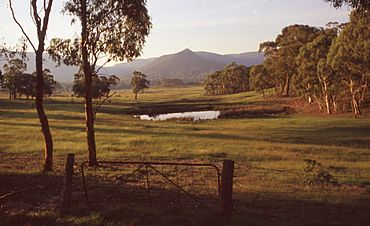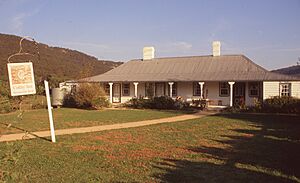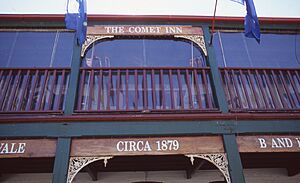Hartley Vale, New South Wales facts for kids
Quick facts for kids Hartley ValeNew South Wales |
|||||||||||||||
|---|---|---|---|---|---|---|---|---|---|---|---|---|---|---|---|

Countryside at Hartley Vale
|
|||||||||||||||
| Postcode(s) | 2790 | ||||||||||||||
| Elevation | 820 m (2,690 ft) | ||||||||||||||
| Location |
|
||||||||||||||
| LGA(s) | City of Lithgow | ||||||||||||||
| County | Cook | ||||||||||||||
| Parish | Hartley | ||||||||||||||
| State electorate(s) | Bathurst | ||||||||||||||
| Federal Division(s) | Macquarie (formerly Calare) | ||||||||||||||
|
|||||||||||||||
|
|||||||||||||||
Hartley Vale is a small village located in the beautiful Blue Mountains region of New South Wales, Australia. It's about 150 kilometres west of Sydney and 12 kilometres south-east of Lithgow. This area is part of the City of Lithgow local government area.
Contents
About Hartley Vale
Hartley Vale is mainly found along Hartley Vale Road. This road stretches from Darling Causeway to the Great Western Highway. The area is mostly open countryside with many large private properties. The River Lett is to the north, and Mount York is to the south.
The village is about five kilometres west of the Main Western Railway. This railway line runs from Sydney to Lithgow and beyond. The closest train station is at Bell, about ten kilometres away.
A Look at Hartley Vale's History
Hartley Vale is a very old area. It was where the first roads over the Blue Mountains came down into the flat lands to the west.
Early Roads and Explorers
The very first road through the mountains was built by William Cox. He worked on it from 1814 to 1815. You can still see parts of his original road at Mount York. These parts are now part of a walking track.
About one kilometre east of Coxs Road is Lockyers Road. Major Lockyer started building this road in 1828. It was meant to be another way to cross the mountains, but it was never finished. It goes down into the valley and ends just west of Hartley Vale village.
Another kilometre east is Lawsons Long Alley. William Lawson started this road. He wanted to avoid the very steep parts of Coxs Road at Mount York. While building it, Lawson found something he thought was coal. It turned out to be oil shale.
Oil Shale Mining History
A scientist named Rev. W. B. Clarke looked at the oil shale in 1841. He wrote a paper about it in 1861. A piece of this oil shale was even shown at a big exhibition in Paris in 1855.
Mining for oil shale began in the 1860s. A special rail line was built into the Kerosene Creek valley. This line had a steep incline designed by Norman Selfe. He also designed what is now the famous Katoomba Scenic Railway. Hartley Vale Station was built on the Main Western Line, but it closed in 1975.
Around 1874, coal was found about 40 feet below the shale. This coal could be used as fuel to help process the oil shale.
Hartley Vale was the longest-running oil shale mining and refining site in New South Wales. Operations happened here between 1865 and 1910. At first, two different companies worked here. But in 1872, they joined together to form the New South Wales Shale and Oil Company. This new company built new processing plants and a refinery at Hartley Vale. In 1906, the Commonwealth Oil Corporation bought the company and its operations.
Mining at Hartley Vale stopped in 1910. However, the refinery was made bigger that same year. It started processing crude oil from other mining sites, like Torbane. The refinery at Hartley Vale first closed around August 1913. It finally shut down completely around May 1914, ending the oil industry in Hartley Vale. You can still see some parts of the old shale oil operations there today.
Community Life and Landmarks
The village had a school from 1872 until 1956, except for a short break in 1946-1947.
Lawsons Long Alley goes through the Kerosene Creek valley. It connects to Waltons Road, which leads to Hartley Vale Road on the east side of the village. Lawsons Long Alley, Lockyers Road, and Coxs Road have all been turned into walking tracks. They all lead to the Hartley Vale area, ending at a picnic spot just west of the village.
Hartley Vale was once on the original path of Bell's Line of Road. This was before a new connection was built between Bell and Lithgow. The part of Hartley Vale Road that goes down into the valley follows some of this old route.
Other important places in the area include the Comet Inn, built in 1879, which is in the village centre. Collits Inn, built in 1823, is about one and a half kilometres west of the village. The Hartley Vale Cemetery is a short distance south-west of Collits Inn. The Hartley Vale area also has other places for tourists to visit.
Heritage-Listed Sites
Hartley Vale has several places that are protected because of their historical importance. These are called heritage-listed sites. They include:
- Hartley Vale Road: Collits' Inn
- Site of oil-shale works, Hartley Vale




